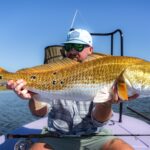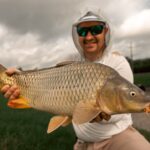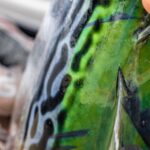
Louisiana Bull Reds Up for Harvest Again: H.B. 604 Must Not Pass
Photo Credit: Carter Abramson | Trevor Johnson Every now and then, we encounter something so
As the albie management train storms down the tracks in North Carolina, we will step aside to process striper related happenings from the recent ASMFC meeting. Our take on the meeting may be a bit different than others, but let’s first take a look at the status of the fishery in 2023:

There is a lot to digest here. First, the recreational sector reduced harvest by 24% relative to 2022. Furthermore, our sector reduced release mortality by 12%. This is the most shocking number to all of us. We heard over and over again about how tightening the slot would result in more dead fish. It was a common theme in almost every discussion. Those who said that were wrong. Again. Consider that a very tight slot limit was enacted in the Chesapeake and the ocean, and catch and release mortality was still reduced. That can only mean one thing: fewer stripers and less effort (directed fishing trips). That is not a great sign for the stock or the fishing economy. The last thing to note is that the Chesapeake’s for-hire harvest increased again. Even though the fleet was moved to one fish plus an extra for the captain and crew, there was still no reduction in harvest. Looking across the aisle, here is the status of the commercial sector.

It looks like the 7% reduction had minimal impact on the fishery. At the recent meeting, we heard Robert T Brown state that the commercials sector couldn’t take another reduction and that the real culprit was release mortality. If the Chesapeake commercial fleet only caught 84% of their quota, MD and PRFC took no reductions. I guess Robert forgot this motion from a previous meeting:

We hope many advocates recall this. There was no reduction but a firm motion to submit a plan that required paybacks for overfishing the quota. The net result was no impact; it was just an inability to catch the quota due to a lack of fish. At some point, we’d love to see commissioners throw out the “BS flag” when statements like this are made at the board. False statements must be challenged at these levels. We need to foster honest conversations. In October, after the stock assessment update, if further reductions are necessary, the commercial sector, specifically in the Chesapeake and Delaware Bay, must take equal reductions, and they must come from harvest, not quota. Otherwise, it is nothing more than smoke and mirrors. During the recent meeting, John Clarke (DE) said that commercial reductions should be proportional. This means that they harvest 10% of the overall take, and therefore, if an 18% reduction is needed, the commercial sector should only take a 1.8% reduction. Our team has a pretty lengthy combined resume of mathematics and statistics studies. Kudos to Mr. Clarke for exposing us to math we have never seen before. One final detail to note is that NOAA has publicly announced that the Fisheries Effort Survey is indeed vastly overestimating recreational effort. That would 100% mean that the commercial harvest of striped bass is greater than 10%. Anyone who understands this but continues diatribe, as previously mentioned, is simply spreading half-truths to cater to <10-gill netters that intercept breeding fish on their way to spawn. Hey Delaware, do better.
The recruitment trigger tripped yet again. In translation, striped bass are not mysteriously spawning in some rivers in the NE or even next to the Molasses Swamp (this may go over the head of our younger advocates).


While we are talking about recruitment, let’s not forget that the Maryland portion of the Chesapeake is below average again this year. From what we understand, it isn’t a total failure, but it isn’t great. The mean is around 11. A failure that trips the trigger is a 4. We are hearing that the 2024 spawn will be between a high end failure or a low end normal. In the immortal words of Ben Franklin, “Three may keep a secret if two are dead.” You can’t hide the facts, Maryland.
The winter tagging survey results came in. It was bleak. Before the same people that believe stripers are spawning in Candyland say the survey is in the wrong place, look at the facts.

Now, if you have ever seen social media in the winter with an angler holding a giant striper with no land in the background, they are usually fishing about 15 miles out in the spots seen in the image. We don’t condone or support this behavior. It makes us sick to be honest. The point is, this is a pretty good representation of where stripers spend their winter.

In 2016, 1240 stripers were tagged via hook and line. In 2024, the number was 38. I guess we don’t need to dig too deep on the analysis of those metrics…
Below is the timeline on the stock assessment. We have a lot of respect for the assessment team and especially the lead at ASMFC, Katie Drew. They will do a good job in mapping out what we have to do to rebuild this stock. As always, our team will attend these meetings and keep our members informed on what the next steps may be. Until then, enjoy the last fleeting days of summer. Catch some fish. Spend time outdoors with those you love. Replace multiple trebles on your lures if you are going to release your stripers and please record your catches on Got One so Mass DMF can finish their catch and release study with an overabundance of data!


Photo Credit: Carter Abramson | Trevor Johnson Every now and then, we encounter something so

This past weekend, ASGA proudly sponsored the Dirty Carp Tournament in Louisiana — and no, you didn’t misread that.

After years of data pouring in from The Albie Project, advocacy, persistence, and support from

This morning, the Connecticut Environment Committee held a hearing on House Bill 6248, a bill
We rely on our members and donations to keep fighting for a sustainable tomorrow in marine conservation.
GIVE THE GIFT OF FISHERIES CONSERVATION THIS HOLIDAY SEASON. SHOP ASGA GOODS THAT FUND FISHERIES RESEARCH & ADVOCACY CAMPAIGNS
JOIN ASGA IN CALLING FOR CRITICAL MANAGEMENT ACTION AFTER YEARS OF SPAWN FAILURES & POOR MANAGEMENT.
By using this website, you agree to our use of cookies. We use cookies to provide you with a great experience and to help our website run effectively. To learn more, please review our privacy policy.
One Response
Thank you for the analysis.